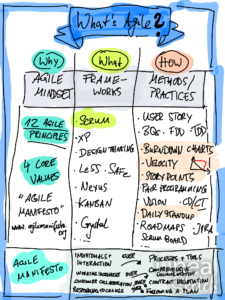Are you considering using Scrum to promote agile working in your organisation? Read here what it can do for you and what you should look out for.
Organisations in the digital age increasingly need to compete in the marketplace and adapt quickly to change. Scrum can be a method to redesign the work in teams and become more agile.
Is Scrum the same as agility?
The quick and simple answer is: No – even if many people mention Scrum and agility in the same breath. From its origins, however, it is initially nothing more than a method and so-called framework for managing complex tasks in teams.
The cooperation of project teams only becomes truly agile through a corresponding mindset. And all those involved have to really get involved in this. I will describe what this can mean in more detail later. Once the appropriate conditions have been created, it is possible for agile teams to tackle complex problems productively, creatively and flexibly. They then develop custom-fit solutions for their customers and deliver products of the highest possible value. Scrum provides a clearly structured framework for this.
Changing structures: Scrum roles versus position titles
With the framework, three roles come into the picture: Scrum Master, Product Owner and Developer. These do not change the usual position titles of the organisation – so you don’t have to print new business cards just because you want to work with Scrum. However, the way we work together will change significantly. This increases the likelihood that sooner or later this will have an influence on existing structures. Click on our page Digital Transformation to learn about the new requirements facing organisations.
The names of the three roles make it clear which responsibilities are associated with them in the Scrum team: For example, the Scrum Master takes on the role of a referee who makes sure that the rules of the framework are strictly adhered to. This ensures that the development teams can work in peace and manage themselves. The product owner is responsible for the interface between the customer, the team and other stakeholders and ensures that the teams create the greatest possible added value for the product.
All this may sound like hierarchy. However, assuming an appropriate mindset, all participants have equal rights and their responsibilities are clearly delineated. They merely have different functions. Ideally, the skills of the individual team members complement each other in such a way that they can optimally pursue the goal of the project.
Ways towards more agility
 Basically, it is much more important to find a common consensus on agile principles in the organisation than to implement an agile framework such as Scrum. If organisations decide to go the Scrum route, the appropriate conditions must be created for this. In our experience, it is a common mistake to introduce agile principles without communicating the idea behind them. The way of working must be understood by everyone and implemented out of inner conviction. Self-leadership, personal responsibility, flexibility and willingness to change in self-managed teams are essential components of an agile mindset. The dichotomy between clear structure and simultaneous flexibility of the work organisation is called agile working.
Basically, it is much more important to find a common consensus on agile principles in the organisation than to implement an agile framework such as Scrum. If organisations decide to go the Scrum route, the appropriate conditions must be created for this. In our experience, it is a common mistake to introduce agile principles without communicating the idea behind them. The way of working must be understood by everyone and implemented out of inner conviction. Self-leadership, personal responsibility, flexibility and willingness to change in self-managed teams are essential components of an agile mindset. The dichotomy between clear structure and simultaneous flexibility of the work organisation is called agile working.
scribble: flow consulting
8 Advantages of Scrum
- Scrum works well for rapidly evolving products and markets.
- It helps teams achieve project goals faster and more effectively than in linear project management.
- The stringent framework creates clear responsibilities.
- Working on large projects in so-called sprints is clearer and easier.
- In the Sprint Review, the result is regularly checked for its market value.
- The Daily Scrum Meetings create transparency about the joint progress in the project.
- The performance of individual team members in the development team becomes transparent through Daily Scrum Meetings.
- Feedback from customers and stakeholders is regularly incorporated.
In our consultations, we encounter more and more organisations that are discovering agile principles for themselves. If you want to find out exactly how Scrum works and is applied, I recommend you browse through the official Scrum Guide. Or you can contact us.
11 tips for the introduction of agile principles like Scrum
During my training to become a Scrum Master, I became very aware of what managers in particular should pay attention to when they want to introduce Scrum or other forms of agile working.
- Provide a clear orientation of what you understand by agile working and how Scrum works.
- Develop your own ‘Agile Manifesto’. This should fit your organisation and be agreed with all stakeholders.
- Agile principles like Scrum are designed to create value for complex problems. For simple challenges, other principles such as project management may be better suited. Realistically assess how complex your environment and challenges really are before adopting an agile framework.
- Once you adopt an agile framework like Scrum, act consistently with it. This means committing to the Scrum Values (Commitment, Focus, Openness, Respect, and Courage), introducing Scrum Events (Sprint, Sprint Planning, Daily Scrum, Sprint Review, Sprint Retroperspective) and Scrum Artifacts (Product Backlog, Sprint Backlog, Increment). Continuously check whether you are generating more value with the introduction of the framework.
- Have some employees undergo Scrum training (e.g. Professional Scrum Master, Professional Scrum Product Owner or Professional Scrum Developer). These can be multipliers of the method in the transformation process.
- Managers and employees must be willing to accept self-determination and dare to allow more decentralisation and a different kind of hierarchy.
- If you introduce Scrum, live it. Avoid a mish-mash of linear project management and Scrum. This applies equally to other agile ways of working.
- Without self-managed teams and without handing over responsibility, truly agile work is not possible. Therefore, create security and freedom from fear with regard to decentralised decisions.
- Allow mistakes. Because they help to create a more valuable product.
- Responsibility makes people grow. Support this by letting your teams experiment and do.
- Put the “we” above the “I”. When everyone pulls together, Scrum can add significant value.
Last but not least: What does Scrum have to do with rugby?
The term scrum comes from sport, more precisely from rugby. Translated, it means “scrum”. An orderly formation of players from each team forms a scrum at the referee’s command. Head to head, shoulder to shoulder, they try to regain possession and get the ball on their own side. Scrum thus describes what is important when teams want to master complex projects: Flexibility, dynamics and goal-oriented agreements.
A “freshly baked” Scrum Master at flow consulting wishes you a successful and agile back-and-forth of the ball in your organisation. 😉
Renke Ulonska
picture: https://pixabay.com/de/photos/sport-rugby-team-spiel-gedränge-3963248/ (jackmac34, kostenfreie Nutzung, 2022-01-23)



